Benefits and Potential Problems of Cultural Diversity in the Workplace: A Case Study of Quadrant Recruitment
Added on 2023-01-19
21 Pages4717 Words33 Views
Equality And Diversity In The Workplace -
Benefits And Potential Problems Of
Cultural Diversity In The Workplace: A
Case Study Of Quadrant Recruitment
Benefits And Potential Problems Of
Cultural Diversity In The Workplace: A
Case Study Of Quadrant Recruitment
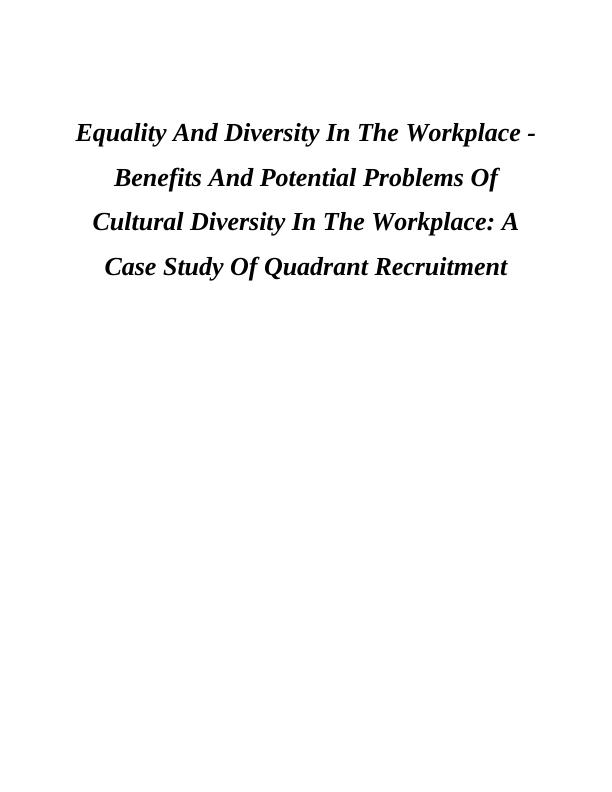
Table of Contents
TITLE .............................................................................................................................................1
CHAPTER 2 Literature Review ...................................................................................................1
CHAPTER 3 Methodology Justification ......................................................................................3
CHAPTER 4 Methodology Explanation ......................................................................................5
CHAPTER 5 Results .....................................................................................................................9
CONCLUSION..............................................................................................................................16
REFERENCES .............................................................................................................................17
.......................................................................................................................................................17
TITLE .............................................................................................................................................1
CHAPTER 2 Literature Review ...................................................................................................1
CHAPTER 3 Methodology Justification ......................................................................................3
CHAPTER 4 Methodology Explanation ......................................................................................5
CHAPTER 5 Results .....................................................................................................................9
CONCLUSION..............................................................................................................................16
REFERENCES .............................................................................................................................17
.......................................................................................................................................................17
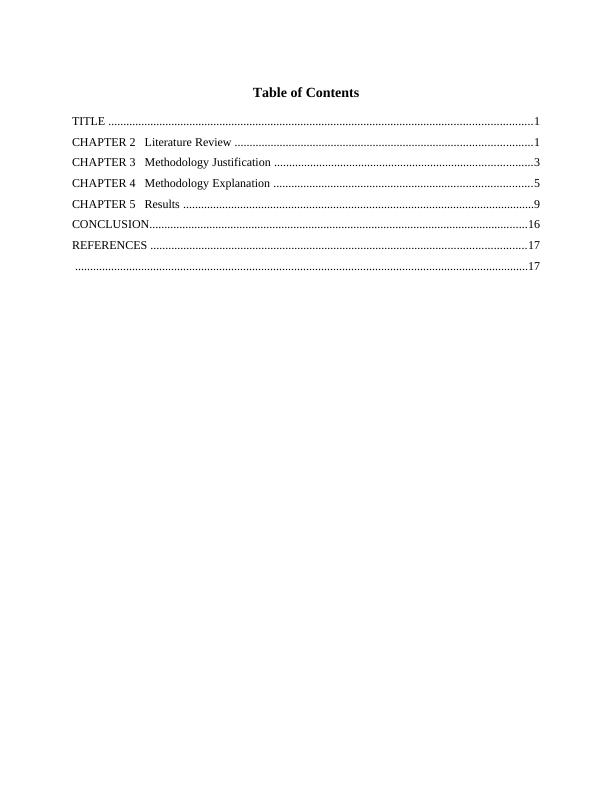
TITLE
To explore the benefits and potential problems of cultural diversity at Quadrant
Recruitment workplaces from individual and organizational perspective.
CHAPTER 2 Literature Review
Literature review is a systematic and effective process of collecting in-depth and accurate
information through various sources such as magazines, books, journal, articles, publication
research etc. Main purpose of this chapter is address each objectives of study systematically
(Haddud, McAllen and DeSouza, 2018).
Benefits of culture diversity in context of employees and organisational performance.
According to the Jennifer Lombardo, 2019, Cultural diversity introduces as a form of
acknowledging the difference in persons. This differences can be based on social status, sexual
orientation, age, sex, gender and ethnicity. Organisations have accomplished the value in getting
a diverse workforce. There are different benefits of cultural diversity for employees as well as
organisation also.
Benefits of cultural diversity for organisation: According to the Angela Stringfellow,
2019, having a diverse workforce is beneficial for an organisation. This will helps an
organisation by increasing creativity, providing variety of perspective, increasing productivity,
reducing fear, improving performance, boosting brand reputation etc. These are major benefits
for any type of organisation who have diverse workforce at workplace. Another benefit of
culture diversity to the business as it helps them by retaining employees for long time which turn
to increase sales and market ration of company.
Benefits of cultural diversity for employees: Cultural diversity is highly essential and
beneficial for employees who have diverse background or nationality (Henry and et. al., 2014).
It helps employees by increasing its performance, improving productivity, improving creativity,
increasing team building skill etc. Thus, cultural diversity is beneficial for workforce to maintain
strong reputation in the organisation.
Potential problems in maintaining cultural diversity at Quadrant Recruitment workplaces.
According to the Katie Reynolds, 2017, the issues in maintaining diversity within
Quadrant Recruitment are upper level authority ideas and thoughts can be challenging to
understand due to different culture and language. The message can be interpret wrong among the
1
To explore the benefits and potential problems of cultural diversity at Quadrant
Recruitment workplaces from individual and organizational perspective.
CHAPTER 2 Literature Review
Literature review is a systematic and effective process of collecting in-depth and accurate
information through various sources such as magazines, books, journal, articles, publication
research etc. Main purpose of this chapter is address each objectives of study systematically
(Haddud, McAllen and DeSouza, 2018).
Benefits of culture diversity in context of employees and organisational performance.
According to the Jennifer Lombardo, 2019, Cultural diversity introduces as a form of
acknowledging the difference in persons. This differences can be based on social status, sexual
orientation, age, sex, gender and ethnicity. Organisations have accomplished the value in getting
a diverse workforce. There are different benefits of cultural diversity for employees as well as
organisation also.
Benefits of cultural diversity for organisation: According to the Angela Stringfellow,
2019, having a diverse workforce is beneficial for an organisation. This will helps an
organisation by increasing creativity, providing variety of perspective, increasing productivity,
reducing fear, improving performance, boosting brand reputation etc. These are major benefits
for any type of organisation who have diverse workforce at workplace. Another benefit of
culture diversity to the business as it helps them by retaining employees for long time which turn
to increase sales and market ration of company.
Benefits of cultural diversity for employees: Cultural diversity is highly essential and
beneficial for employees who have diverse background or nationality (Henry and et. al., 2014).
It helps employees by increasing its performance, improving productivity, improving creativity,
increasing team building skill etc. Thus, cultural diversity is beneficial for workforce to maintain
strong reputation in the organisation.
Potential problems in maintaining cultural diversity at Quadrant Recruitment workplaces.
According to the Katie Reynolds, 2017, the issues in maintaining diversity within
Quadrant Recruitment are upper level authority ideas and thoughts can be challenging to
understand due to different culture and language. The message can be interpret wrong among the
1
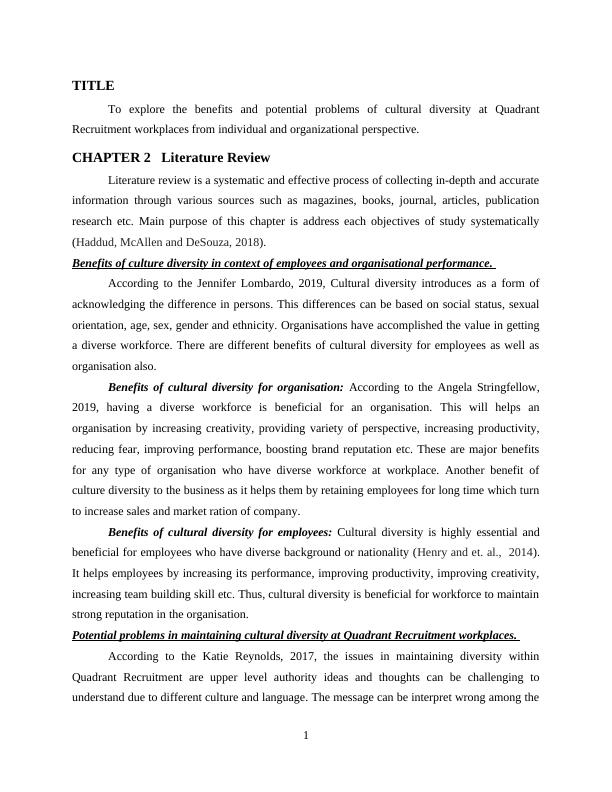
colleagues who are from the different cultures. Recruit the talent from other countries is also a
challenge for Quadrant Recruitment because to fulfil visa requirement of the international
employees is a time consuming as well as complicated process to carried out. The professional
etiquette of employees from different cultures may arise misunderstanding among the group
members. For Example, in Japan no employee can leave office before their managing director
while in Swedish it is six hours working day by professionals.
As per the view point of Big Think Edge, 2018, Age difference among the employees is
a big issue in maintaining diversity in Quadrant Recruitment. New employees can be hired from
different countries while existing workforce are retiring from the organisation. Different age
groups have different perception of viewing the things and thus creates problems in
understanding the perception of employees who are below or above the age of them. In addition
to this, respecting others workforce culture is a issue as some employees did not easily involved
or follow others culture and thus create problems in Quadrant Recruitment . Sometimes adoption
of new rules & policies by the employees of different cultures is also creates problem in
maintaining cultural diversity at workplace.
Ways through which Quadrant Recruitment can overcome issues in culture diversity.
According to the Hebl and Avery, 2012, there are different ways by which Quadrant
Recruitment can easily solve issue in cultural diversity. Company must communicate the
diversity policy regularly and clearly, it will helps them in reducing conflict among employees
which will be beneficial for success and growth of business. Company must train train their
employees who have lack of knowledge and skill about the business. Diverse workforce require
training section for improving their language. It will support an enterprise to attract large number
of customers easily. Quadrant Recruitment, promote appreciation of cultural differences will also
support an organisation to overcome impact of cultural diversity.
2
challenge for Quadrant Recruitment because to fulfil visa requirement of the international
employees is a time consuming as well as complicated process to carried out. The professional
etiquette of employees from different cultures may arise misunderstanding among the group
members. For Example, in Japan no employee can leave office before their managing director
while in Swedish it is six hours working day by professionals.
As per the view point of Big Think Edge, 2018, Age difference among the employees is
a big issue in maintaining diversity in Quadrant Recruitment. New employees can be hired from
different countries while existing workforce are retiring from the organisation. Different age
groups have different perception of viewing the things and thus creates problems in
understanding the perception of employees who are below or above the age of them. In addition
to this, respecting others workforce culture is a issue as some employees did not easily involved
or follow others culture and thus create problems in Quadrant Recruitment . Sometimes adoption
of new rules & policies by the employees of different cultures is also creates problem in
maintaining cultural diversity at workplace.
Ways through which Quadrant Recruitment can overcome issues in culture diversity.
According to the Hebl and Avery, 2012, there are different ways by which Quadrant
Recruitment can easily solve issue in cultural diversity. Company must communicate the
diversity policy regularly and clearly, it will helps them in reducing conflict among employees
which will be beneficial for success and growth of business. Company must train train their
employees who have lack of knowledge and skill about the business. Diverse workforce require
training section for improving their language. It will support an enterprise to attract large number
of customers easily. Quadrant Recruitment, promote appreciation of cultural differences will also
support an organisation to overcome impact of cultural diversity.
2
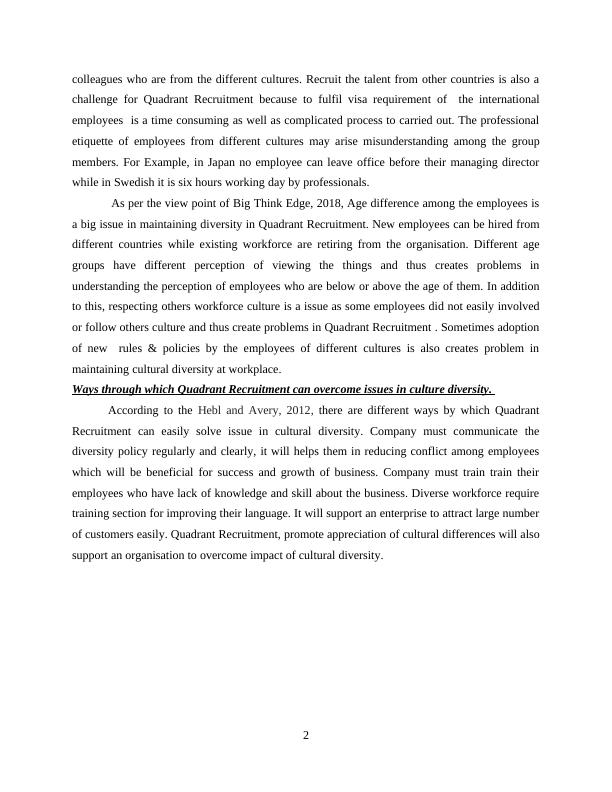
CHAPTER 3 Methodology Justification
Primary research: This is defined as an useful methodology that is used by investigator
to gather information directly, rather than relaying on data gathered from previously done study.
This research is exclusively carried out to address some issue, which requires detailed and in-
depth analysis (Flick, 2015). There are different methods of primary research such as focus
group, interview, questionnaire, observations etc. These are main methods which helps
researcher to collect accurate information about the current study. These methods will be
determine as below:
Observations: It is a method of primary research, there is indirect interaction between
investigator and respondent (employees) being observed. In this, investigator notice the reaction
of a respondent and makes notes. Along with this, trained observers are applied to record
reactions of respondents (Gioia, Corley and Hamilton, 2013).
Interview: It is a qualitative research method which is used to collect information from
the respondent. Interviews are consider open-ended method which includes interaction between
researcher and respondent. Interviews are a suitable method when there is a high requirement to
gather in-depth data on people's opinions, experiences, feelings and thoughts (Green, Camilli and
Elmore, 2012).
Questionnaire: This is defined as an important instrument of research that consists a
different questions that purpose to gather data from a respondent. There are basically two types
of questions which are open-ended and close-ended. Open-ended questions are consider main
part of interview method whereas close-ended questions are consider effective part of
questionnaire instrument (Kumar, 2019).
Focus group: This is another technique of primary data collection which is applied to
gather information from small number of people, mainly restricted to 6-10. Group of respondents
are work together to discuss their opinions, experiences, feelings and thoughts about company.
These are good and effective way of getting accurate data regarding small number of people
(Mackenzie, Tan, Hoverman and Baldwin, 2012).
Therefore, all these are effective methods of data collection but for analysing opinion of
employee about the impact of cultural diversity, questionnaire is more suitable and useful
instrument of primary data collection (Hewins-Maroney and Williams, 2013). There are some
3
Primary research: This is defined as an useful methodology that is used by investigator
to gather information directly, rather than relaying on data gathered from previously done study.
This research is exclusively carried out to address some issue, which requires detailed and in-
depth analysis (Flick, 2015). There are different methods of primary research such as focus
group, interview, questionnaire, observations etc. These are main methods which helps
researcher to collect accurate information about the current study. These methods will be
determine as below:
Observations: It is a method of primary research, there is indirect interaction between
investigator and respondent (employees) being observed. In this, investigator notice the reaction
of a respondent and makes notes. Along with this, trained observers are applied to record
reactions of respondents (Gioia, Corley and Hamilton, 2013).
Interview: It is a qualitative research method which is used to collect information from
the respondent. Interviews are consider open-ended method which includes interaction between
researcher and respondent. Interviews are a suitable method when there is a high requirement to
gather in-depth data on people's opinions, experiences, feelings and thoughts (Green, Camilli and
Elmore, 2012).
Questionnaire: This is defined as an important instrument of research that consists a
different questions that purpose to gather data from a respondent. There are basically two types
of questions which are open-ended and close-ended. Open-ended questions are consider main
part of interview method whereas close-ended questions are consider effective part of
questionnaire instrument (Kumar, 2019).
Focus group: This is another technique of primary data collection which is applied to
gather information from small number of people, mainly restricted to 6-10. Group of respondents
are work together to discuss their opinions, experiences, feelings and thoughts about company.
These are good and effective way of getting accurate data regarding small number of people
(Mackenzie, Tan, Hoverman and Baldwin, 2012).
Therefore, all these are effective methods of data collection but for analysing opinion of
employee about the impact of cultural diversity, questionnaire is more suitable and useful
instrument of primary data collection (Hewins-Maroney and Williams, 2013). There are some
3
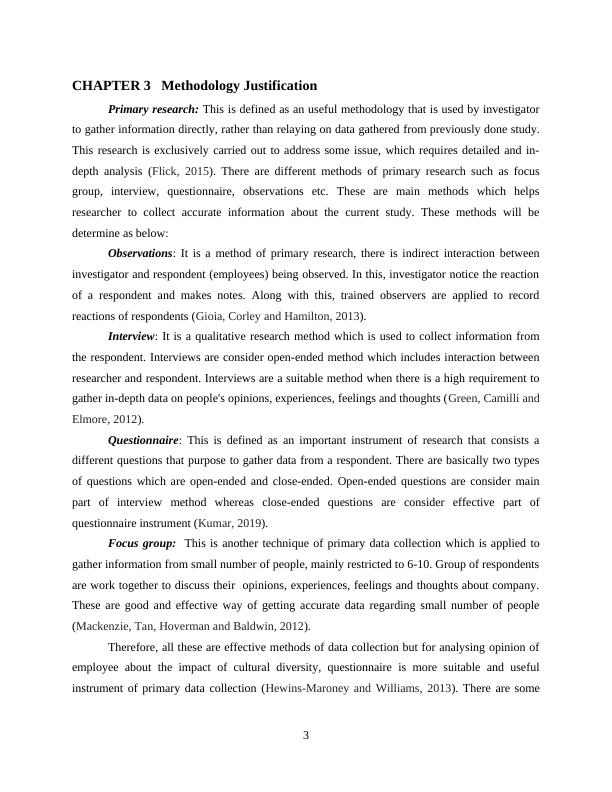
advantages of questionnaire and disadvantages of other three methods i.e. observation, focus
group and interview will be determined as below:
Advantages of questionnaire
Primary
method of data
Collection
Advantages
Questionnaire One of the main advantage of following questionnaires instrument is that a
large group of employee can be reached comparatively easily as well as
economically. A standard questionnaire gives quantifiable and accurate
answers for a current topic (Mackey and Gass, 2015). These answers are
comparatively easy for researcher to analyse accurate information regarding
the impact of cultural diversity. Another main reason for selecting
questionnaire is it provide valid and reliable information about the topic.
Disadvantages of observation, focus group and interview
Primary method of
data Collection
Disadvantages
Observation One of the main disadvantage of observation as a method of data
collection, it may require training which take more money from
Quadrant Recruitment (McCusker and Gunaydin, 2015).
Focus group Main disadvantage of focus group method as it is not easy to encourage
a group of people to participate.
Interview This is a more costly and time consuming method as compare to
questionnaire.
Research design: In order to minimise above discussed disadvantages of primary data
collection, there are some types of research design which are experimental, descriptive,
exploratory (Miller and et. al., 2012). These are effective research design which helps researcher
to minimise the impact of research. Along with this, descriptive design is more suitable and
4
group and interview will be determined as below:
Advantages of questionnaire
Primary
method of data
Collection
Advantages
Questionnaire One of the main advantage of following questionnaires instrument is that a
large group of employee can be reached comparatively easily as well as
economically. A standard questionnaire gives quantifiable and accurate
answers for a current topic (Mackey and Gass, 2015). These answers are
comparatively easy for researcher to analyse accurate information regarding
the impact of cultural diversity. Another main reason for selecting
questionnaire is it provide valid and reliable information about the topic.
Disadvantages of observation, focus group and interview
Primary method of
data Collection
Disadvantages
Observation One of the main disadvantage of observation as a method of data
collection, it may require training which take more money from
Quadrant Recruitment (McCusker and Gunaydin, 2015).
Focus group Main disadvantage of focus group method as it is not easy to encourage
a group of people to participate.
Interview This is a more costly and time consuming method as compare to
questionnaire.
Research design: In order to minimise above discussed disadvantages of primary data
collection, there are some types of research design which are experimental, descriptive,
exploratory (Miller and et. al., 2012). These are effective research design which helps researcher
to minimise the impact of research. Along with this, descriptive design is more suitable and
4
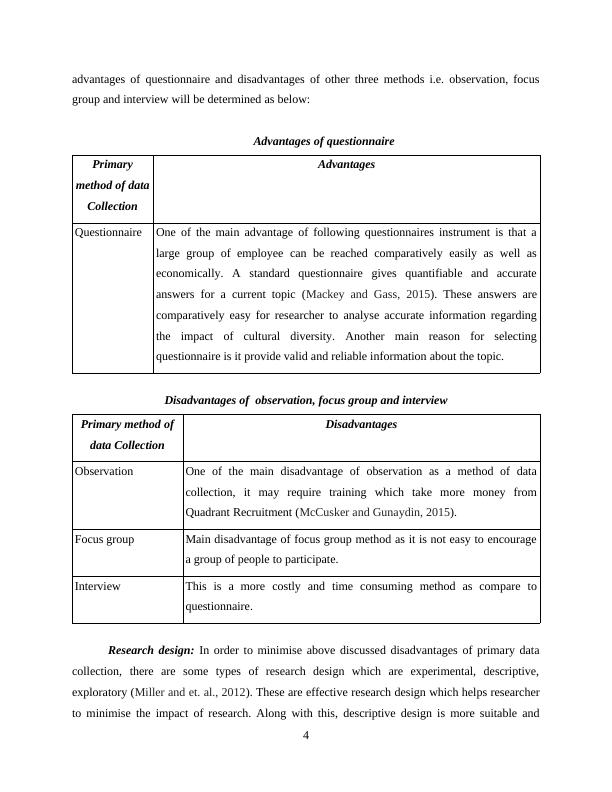
End of preview
Want to access all the pages? Upload your documents or become a member.
Related Documents
Research Projectlg...
|20
|4145
|64
Contribution of Cultural Diversity in Promotion of Innovation in Workplacelg...
|21
|6829
|48
Role of Diversity in Reducing Employee Turnover in ASDAlg...
|28
|6224
|21
Managing Diversity and Cultural Differences to achieve Organizational Goals in British Airwayslg...
|12
|2817
|225
Contribution of Cultural Diversity in Promoting Innovation at Workplacelg...
|22
|6888
|1
Managing Cultural Diversity in the Workplacelg...
|24
|5330
|46
